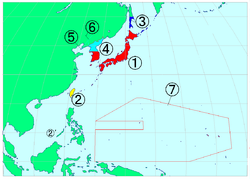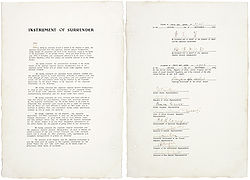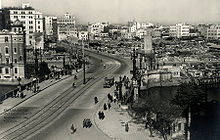- Occupation of Japan
-
Occupied Japan Military occupation ← 
1945–1952  →
→
 →
→
 →
→

Flag¹ Imperial Seal Dissolution of the Japanese Empire. See image for further information. Capital Tokyo Language(s) Japanese Political structure Military occupation Military Governor - 1945-1951 Douglas MacArthur - 1951-1952 Matthew Ridgway Emperor - 1945-1952 Hirohito Historical era WWII/Cold War - Surrender of Japan August 14, 1945 - Established August 28, 1945 - Instrument of Surrender signed September 2, 1945 - San Francisco Treaty April 28, 1952 History of Japan 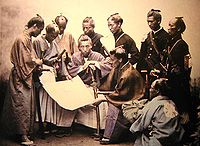
- Paleolithic 35,000–14,000 BC
- Jōmon period 14,000–300 BC
- Yayoi period 300 BC–250 AD
- Kofun period 250–538
- Asuka period 538–710
- Nara period 710–794
- Heian period 794–1185
- Kamakura period
1185–1333- Kenmu restoration
1333–1336
- Kenmu restoration
- Muromachi period (Ashikaga)
1336–1573- Nanboku-chō period
1336–1392 - Sengoku period
1467–1573
- Nanboku-chō period
- Azuchi–Momoyama period
1568–1603 - Edo period (Tokugawa)
1603–1868 - Meiji period 1868–1912
- Taishō period 1912–1926
- Shōwa period 1926–1989
- Shōwa financial crisis
- Japanese militarism
- Occupation of Japan
- Post-occupation Japan
- Heisei period 1989–present
- Lost Decade
- Empire of Japan (prewar)
1868–1945 (political entity) - Japan (postwar)
1945–present (political entity) - Economic history
-
- History of currency
- Educational history
- Military history
- Naval history
- History of seismicity
At the end of World War II, Japan was occupied by the Allied Powers, led by the United States with contributions also from Australia, India, New Zealand and the United Kingdom. This foreign presence marked the first time in its history that the island nation had been occupied by a foreign power.[1] The San Francisco Peace Treaty, signed on September 8, 1951, marked the end of the Allied occupation, and after it came into force on April 28, 1952, Japan was once again an independent country.
Contents
Surrender
Japan initially surrendered to the Allies on August 14, 1945, when the Japanese government notified the Allies that it had accepted the Potsdam Declaration. On the following day, Emperor Hirohito announced Japan's unconditional surrender on the radio (the Gyokuon-hōsō). The announcement was the emperor's first ever radio broadcast and the first time most citizens of Japan ever heard their sovereign's voice.[2] This date is known as Victory Over Japan, or V-J Day, and marked the end of World War II and the beginning of a long road to recovery for a shattered Japan.
On V-J Day, United States President Harry Truman appointed General Douglas MacArthur as Supreme Commander of the Allied Powers (SCAP), to supervise the occupation of Japan. During the war, the Allied Powers had planned to divide Japan amongst themselves for the purposes of occupation, as was done for the occupation of Germany. Under the final plan, however, SCAP was given direct control over the main islands of Japan (Honshū, Hokkaidō, Shikoku and Kyūshū) and the immediately surrounding islands, while outlying possessions were divided between the Allied Powers as follows:
- Soviet Union: North Korea (not a full occupation), Sakhalin, and the Kuril Islands
- United States: South Korea (not a full occupation), Okinawa, the Amami Islands, the Ogasawara Islands and Japanese possessions in Micronesia
- Republic of China: Taiwan and Penghu
It is unclear why the occupation plan was changed. Common theories include the increased power of the United States following development of the atomic bomb, Truman's greater distrust of the Soviet Union when compared with Roosevelt, and an increased desire to contain Soviet expansion in the Far East after the Yalta Conference.
The Soviet Union had some intentions of occupying Hokkaidō.[3] Had this occurred, there might have been the foundation of a communist "Democratic People's Republic of Japan" in the Soviet zone of occupation. However, unlike the Soviet occupations of East Germany and North Korea, these plans were frustrated by the opposition of President Truman.[3]
The Far Eastern Commission and Allied Council for Japan were also established to supervise the occupation of Japan.[4]
Japanese officials left for Manila on August 19 to meet MacArthur and to be briefed on his plans for the occupation. On August 28, 150 U.S. personnel flew to Atsugi, Kanagawa Prefecture. They were followed by USS Missouri, whose accompanying vessels landed the 4th Marine Division on the southern coast of Kanagawa. Other Allied personnel followed.
MacArthur arrived in Tokyo on August 30, and immediately decreed several laws: No Allied personnel were to assault Japanese people. No Allied personnel were to eat the scarce Japanese food. Flying the Hinomaru or "Rising Sun" flag was initially severely restricted (although individuals and prefectural offices could apply for permission to fly it). The restriction was partially lifted in 1948 and completely lifted the following year.[5]
1946 newsreel
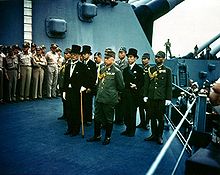 Representatives of Japan stand aboard the USS Missouri prior to signing of the Instrument of Surrender.
Representatives of Japan stand aboard the USS Missouri prior to signing of the Instrument of Surrender.
On September 2, Japan formally surrendered with the signing of the Japanese Instrument of Surrender. On September 6, US President Harry S. Truman approved a document titled "US Initial Post-Surrender Policy for Japan".[6] The document set two main objectives for the occupation: (1) eliminating Japan's war potential and (2) turning Japan into a western style nation with pro-American orientation. Allied (primarily American) forces were set up to supervise the country, and "for eighty months following its surrender in 1945, Japan was at the mercy of an army of occupation, its people subject to foreign military control."[7] At the head of the Occupation administration was General MacArthur who was technically supposed to defer to an advisory council set up by the Allied powers, but in practice did everything himself. As a result, this period was one of significant American influence, having been already identified in 1951, that "for six years the United States has had a freer hand to experiment with Japan than any other country in Asia, or indeed in the entire world."[8]
MacArthur's first priority was to set up a food distribution network; following the collapse of the ruling government and the wholesale destruction of most major cities, virtually everyone was starving. Even with these measures, millions of people were still on the brink of starvation for several years after the surrender.[9] As expressed by Kawai Kazuo, "Democracy cannot be taught to a starving people,"[10] and while the US government encouraged democratic reform in Japan, it also sent billions of dollars in aid.[11]
Initially the US government provided emergency food relief through GARIOA funds. In fiscal year 1946, this aid amounted to US$92 million in loans. From April 1946, in the guise of LARA, private relief organizations were also permitted to provide relief. Once the food network was in place, at a cost of up to US$1 million[citation needed] per day, MacArthur set out to win the support of Hirohito. The two men met for the first time on September 27; the photograph of the two together is one of the most famous in Japanese history. However, many were shocked that MacArthur wore his standard duty uniform with no tie instead of his dress uniform when meeting the emperor. MacArthur may have done this on purpose, to send a message as to what he considered the emperor's status to be.[12] With the sanction of Japan's reigning monarch, MacArthur had the ammunition he needed to begin the real work of the occupation. While other Allied political and military leaders pushed for Hirohito to be tried as a war criminal, MacArthur resisted such calls and rejected the claims of members of the imperial family such as Prince Mikasa and Prince Higashikuni and intellectuals like Tatsuji Miyoshi who asked for the emperor's abdication,[13] arguing that any such prosecution would be overwhelmingly unpopular with the Japanese people.
By the end of 1945, more than 350,000 U.S. personnel were stationed throughout Japan. By the beginning of 1946, replacement troops began to arrive in the country in large numbers and were assigned to MacArthur's Eighth Army, headquartered in Tokyo's Dai-Ichi building. Of the main Japanese islands, Kyūshū was occupied by the 24th Infantry Division, with some responsibility for Shikoku. Honshū was occupied by the First Cavalry Division. Hokkaidō was occupied by the 11th Airborne Division.
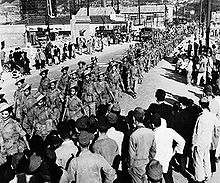 The 2nd Battalion, 5th Royal Gurkha Rifles marching through Kure soon after their arrival in Japan. (May 1946)
The 2nd Battalion, 5th Royal Gurkha Rifles marching through Kure soon after their arrival in Japan. (May 1946)
By June 1950, all of these army units had suffered extensive troop reductions, and their combat effectiveness was seriously weakened. When North Korea invaded South Korea, elements of the 24th Division were flown into South Korea to try to stem the massive invasion force there, but the green occupation troops, while acquitting themselves well when suddenly thrown into combat almost overnight, suffered heavy casualties and were forced into retreat until other Japan occupation troops could be sent to assist.
The official British Commonwealth Occupation Force (BCOF), composed of Australian, British, Indian and New Zealand personnel, was deployed on February 21, 1946. While U.S. forces were responsible for overall military government, BCOF was responsible for supervising demilitarization and the disposal of Japan's war industries. [1] BCOF was also responsible for occupation of several western prefectures and had its headquarters at Kure. At its peak, the force numbered about 40,000 personnel. During 1947, BCOF began to decrease its activities in Japan, and officially wound up in 1951.
Outcomes of the occupation
Disarmament
Japan's postwar constitution, adopted under Allied supervision, included a "Peace Clause" (Article 9), which renounced war and banned Japan from maintaining any armed forces. This was intended to prevent the country from ever becoming an aggressive military power again. However, within a decade, America was pressuring Japan to rebuild its army as a bulwark against Communism in Asia after the Chinese Civil War and the Korean War, and Japan established Self-Defense Forces. Traditionally, Japan's military spending has been restricted to about 1% of its GNP, though this is by popular practice, not law, and has fluctuated up and down from this figure. Recently, past Prime Ministers Junichiro Koizumi and Shinzo Abe, and other politicians have tried to repeal or amend the clause. Although the intention of the American Occupation was to demilitarize the Japanese, due to the subsequent Asian threat of communism, and at American urging, the Japanese military was slowly restored to considerable strength. Japan currently has the sixth largest military budget in the world.[14]
Liberalization
The Occupation was not the simple experiment in democracy it is often portrayed to be. With the intensification of the Cold War, SCAP reined in its reform initiatives. From late 1947, US Priorities shifted perceptibly from liberal social change to internal political stability and economic recovery. Demilitarisation and democratization lost momentum and then seemed to stall. Economic deconcentration, for example, was left uncompleted as GHQ responded to new imperatives. American authorities encouraged business practices and industrial policies that have since become sources of contention between Japan and its major trade partners, notably the United States.[15] During the Occupation, GHQ/SCAP successfully (if not entirely) abolished many of the financial coalitions known as the Zaibatsu, which had previously monopolized industry.[16] Along with the later American change of heart, however (due in part to the need for an economically stronger Japan in the face of a perceived Soviet threat), these economic reforms were also hampered by the wealthy and influential Japanese who obviously stood to lose a great deal. As such, there were those who consequently resisted any attempts at reform, claiming that the zaibatsu were required for Japan to compete internationally, and looser industrial groupings known as keiretsu evolved. A major land reform was also conducted, led by Wolf Ladejinsky of General Douglas MacArthur's SCAP staff. However, Ladejinsky has stated that the real architect of reform was Socialist Hiro Wada, former Japanese Minister of Agriculture.[17] Between 1947 and 1949, approximately 5,800,000 acres (23,000 km2) of land (approximately 38% of Japan's cultivated land) were purchased from the landlords under the government's reform program and resold at extremely low prices (after inflation) to the farmers who worked them. By 1950, three million peasants had acquired land, dismantling a power structure that the landlords had long dominated.[18]
Democratization
In 1946, the Diet ratified a new Constitution of Japan that followed closely a 'model copy' prepared by the GHQ/SCAP,[19] and was promulgated as an amendment to the old Prussian-style Meiji Constitution. "The political project drew much of its inspiration from the US Bill of Rights, New Deal social legislation, the liberal constitutions of several European states and even the Soviet Union... (It) transferred sovereignty from the Emperor to the people in an attempt to depoliticize the Throne and reduce it to the status of a state symbol. Included in the revised charter was the famous 'no war', 'no arms' Article Nine, which outlawed belligerency as an instrument of state policy and the maintenance of a standing army. The 1947 Constitution also enfranchised women, guaranteed fundamental human rights, strengthened the powers of Parliament and the Cabinet, and decentralized the police and local government."[20] On December 15, 1945 the Shinto Directive was issued abolishing Shinto as a state religion and prohibiting some of its teachings and rites that were deemed to be militaristic or ultra-nationalistic. On April 10, 1946, an election that saw 78.52% voter turnout among men and 66.97% among women[21] gave Japan its first modern prime minister, Shigeru Yoshida.
Trade Union Act
In 1945 the Diet passed Japan's first ever trade union law protecting the rights of workers to form or join a union, to organize and take industrial action. There had been pre-war attempts to do so, but none that were successfully passed until the Allied occupation.[22] A new Trade Union law was passed on June 1 1949, which remains in place to the present day. According to Article 1 of the Act, the purpose of the act is to "elevate the status of workers by promoting their being on equal standing with the employer".[23]
Labor Standards Act
The Labor Standards Act was enacted on 7 April, 1947 to govern working conditions in Japan. According to Article 1 of the Act, its goal is to ensure that "Working conditions shall be those which should meet the needs of workers who live lives worthy of human beings."[24] While it was created while Japan was under occupation, the origins of the Act have nothing to do with the occupation forces. It appears to have been the brainchild of Kosaku Teramoto, a former member of the Thought Police, who had become the head of the Labor Standards section of the Welfare Ministry.[25]
Education reform
Before and during the war, Japanese education was based on the German system, with "Gymnasium" (selective grammar schools) and universities to train students after primary school. During the occupation, Japan's secondary education system was changed to incorporate three-year junior high schools and senior high schools similar to those in the U.S.: junior high became compulsory but senior high remained optional. The Imperial Rescript on Education was repealed, and the Imperial University system reorganized. The longstanding issue of Japanese script reform, which had been planned for decades but continuously opposed by more conservative elements, was also resolved during this time. The Japanese written system was drastically reorganized with the Tōyō kanji-list in 1946, predecessor of today's Jōyō kanji, and orthography was greatly altered to reflect spoken usage.
Negative impact of the occupation

Purging of war criminals
While these other reforms were taking place, various military tribunals, most notably the International Military Tribunal for the Far East in Ichigaya, were trying Japan's war criminals and sentencing many to death and imprisonment. However, many suspects such as Tsuji Masanobu, Nobusuke Kishi, Yoshio Kodama and Ryoichi Sasakawa were never judged, while the Showa Emperor, all members of the imperial family implicated in the war such as Prince Chichibu, Prince Asaka, Prince Hiroyasu Fushimi, Prince Higashikuni and Prince Takeda, and all members of Unit 731 were given immunity from criminal prosecution by General MacArthur.
Before the war crimes trials actually convened, the SCAP, the IPS and Shōwa officials worked behind the scenes not only to prevent the imperial family from being indicted, but also to slant the testimony of the defendants to ensure that no one implicated the Emperor. High officials in court circles and the Shōwa government collaborated with Allied GHQ in compiling lists of prospective war criminals, while the individuals arrested as Class A suspects and incarcerated in Sugamo prison solemnly vowed to protect their sovereign against any possible taint of war responsibility.[26] Thus, "months before the Tokyo tribunal commenced, MacArthur's highest subordinates were working to attribute ultimate responsibility for Pearl Harbor to Hideki Tōjō"[27] by allowing "the major criminal suspects to coordinate their stories so that the Emperor would be spared from indictment."[28] and "with the full support of MacArthur's headquarters, the prosecution functioned, in effect, as a defense team for the emperor."[29]
For historian John W. Dower,
Even Japanese peace activists who endorse the ideals of the Nuremberg and Tokyo charters, and who have labored to document and publicize Japanese atrocities, cannot defend the American decision to exonerate the emperor of war responsibility and then, in the chill of Cold war, release and soon afterwards openly embrace accused right-wing war criminals like the later prime minister Kishi Nobusuke.[30] In retrospect, apart from the military officer corps, the purge of alleged militarists and ultranationalists that was conducted under the Occupation had relatively small impact on the long-term composition of men of influence in the public and private sectors. The purge initially brought new blood into the political parties, but this was offset by the return of huge numbers of formally purged conservative politicians to national as well as local politics in the early 1950s. In the bureaucracy, the purge was negligible from the outset... In the economic sector, the purge similarly was only mildly disruptive, affecting less than sixteen hundred individuals spread among some four hundred companies. Everywhere one looks, the corridors of power in postwar Japan are crowded with men whose talents had already been recognized during the war years, and who found the same talents highly prized in the "new" Japan.[31]Rape
Main article: Rape during the occupation of JapanWhile many Japanese civilians feared that the Allied troops were likely to rape Japanese women, the incidence of rape committed by members of the occupation force was low.[32] Its incidence did increase after the criminalization of prostitution, however.[33] Michael S. Molasky reports that while rape and other violent crime was widespread in naval ports like Yokosuka and Yokohama during the first few weeks of occupation, according to Japanese police reports, the number of incidents declined shortly after and were not common on mainland Japan throughout the rest of occupation.[34]
According to Toshiyuki Tanaka, 76 cases of rape or rape-murder were reported on Okinawa during the first five years of occupation. However, contemporary research indicates that this number is likely too small as many rapes went unreported.[35]
Censorship
See also: Censorship in Japan#Occupation of Japan and Rape during the occupation of Japan#Censorship of Japanese_mediaAfter the surrender of Japan in 1945, the Supreme Commander of the Allied Powers abolished all forms of censorship and controls on Freedom of Speech, which was also integrated into Article 21 of the 1947 Constitution of Japan. However, press censorship remained a reality in the post-war era, especially in matters of pornography, and in political matters deemed subversive by the American government during the occupation of Japan.
The Allied occupation forces suppressed news of criminal activities such as rape; on September 10, 1945 SCAP "issued press and pre-censorship codes outlawing the publication of all reports and statistics 'inimical to the objectives of the Occupation'."[36]
According to David M. Rosenfeld:
Not only did Occupation censorship forbid criticism of the United States or other Allied nations, but the mention of censorship itself was forbidden. This means, as Donald Keene observes, that for some producers of texts "the Occupation censorship was even more exasperating than Japanese military censorship had been because it insisted that all traces of censorship be concealed. This meant that articles had to be rewritten in full, rather than merely submitting XXs for the offending phrases."Industrial disarmament
To further remove Japan as a potential future threat to the U.S., the Far Eastern Commission decided that Japan was to be partly de-industrialized. The necessary dismantling of Japanese industry was foreseen to have been achieved when Japanese standards of living had been reduced to those existing in Japan the period 1930 - 1934.[38][39] In the end the adopted program of de-industrialisation in Japan was implemented to a lesser degree than the similar U.S. "industrial disarmament" program in Germany.[38] In view of the cost to American taxpayers for emergency food aid to Japan, in April 1948 the Johnston Committee Report recommended that the economy of Japan should instead be reconstructed. The report included suggestions for reductions in war reparations, and a relaxation of the "economic deconcentration" policy. For the fiscal year of 1949 funds were moved from the GARIOA budget into an Economic Rehabilitation in Occupied Areas (EROA) programme, to be used for the import of materials needed for economic reconstruction.
Comfort women
With the acceptance of the Allied occupation authorities the Japanese organized a brothel system for the benefit of the more than 300,000 occupation troops. "The strategy was, through the special work of experienced women, to create a breakwater to protect regular women and girls."
In December 1945 a senior officer with the Public Health and Welfare Division of the occupation's General Headquarters wrote regarding the typical prostitute:
- "The girl is impressed into contracting by the desperate financial straits of her parents and their urging, occasionally supplemented by her willingness to make such a sacrifice to help her family," he wrote. "It is the belief of our informants, however, that in urban districts the practice of enslaving girls, while much less prevalent than in the past, still exists."
"The worst victims ... were the women who, with no previous experience, answered the ads calling for 'Women of the New Japan,"'
When MacArthur finally closed the brothels on March 25, 1946, it is estimated that more than 25% of the U.S. troops had sexually transmitted diseases.[40][41][42][43]
Expulsions
The defeat of the Japanese Empire meant reversal of its previous annexations—Taiwan and Manchuria were returned to China, while Korea regained its independence.
The Soviet Union claimed South Sakhalin and the Kuril Islands, with 400,000 Japanese fleeing or expelled. Similar actions happened in Taiwan and Manchuria after their return to China, while independent Korea saw flight of over 800,000 Japanese settlers—fearing reprisals for Japanese war crimes and decades of looting of the peninsula by settlers.
Other
In a bid to occupy as much Japanese territory as possible, Soviet troops continued offensive military operations after the Japanese surrender, causing large scale civilian casualties.[44]
Politics
Unlike the case in Germany Japan retained a native government throughout the occupation, although its de facto authority was strictly limited at first and senior figures in the government such as the Prime Minister effectively served at the pleasure of the occupational authorities prior to the first post-war elections being held.
Political parties had begun to revive almost immediately after the occupation began. Left-wing organizations, such as the Japan Socialist Party and the Japan Communist Party, quickly reestablished themselves, as did various conservative parties. The old Seiyukai and Rikken Minseito came back as, respectively, the Liberal Party (Nihon Jiyuto) and the Japan Progressive Party (Nihon Shimpoto). The first postwar elections were held in 1946 (women were given the franchise for the first time), and the Liberal Party's vice president, Yoshida Shigeru (1878–1967), became prime minister. For the 1947 elections, anti-Yoshida forces left the Liberal Party and joined forces with the Progressive Party to establish the new Japan Democratic Party (Minshuto). This divisiveness in conservative ranks gave a plurality to the Japan Socialist Party, which was allowed to form a cabinet, which lasted less than a year. Thereafter, the socialist party steadily declined in its electoral successes. After a short period of Democratic Party administration, Yoshida returned in late 1948 and continued to serve as prime minister until 1954. However, because of a heart failure Yoshida was replaced by Shinto in 1955.
End of the occupation
In 1949, MacArthur made a sweeping change in the SCAP power structure that greatly increased the power of Japan's native rulers, and the occupation began to draw to a close. The San Francisco Peace Treaty, signed on September 8, 1951, marked the end of the Allied occupation, and when it went into effect on April 28, 1952, Japan was once again an independent state (with the exceptions of Okinawa, which remained under U.S. control until 1972, and Iwo Jima, which remained under US control until 1968). Even though some 31,000 U.S. military personnel remain in Japan today, they are there at the invitation of the Japanese government under the terms of the Treaty of Mutual Cooperation and Security between the United States and Japan (1960) and not as an occupying force.
Criticism of the occupation
On the day the occupation of Japan was over, the Asahi Shimbun published a very critical essay on the occupation, claiming it turned the Japanese population "irresponsible, obsequious and listless . . . unable to perceive issues in a forthright manner, which led to distorted perspectives".[45]
Cultural reaction
Hirohito’s surrender broadcast was a profound shock to Japanese citizens. After years of being told about Japan’s military might and the inevitability of victory, these beliefs were proven false in the space of a few minutes. But for many people, these were only secondary concerns since they were also facing starvation and homelessness.
Post-war Japan was chaotic. The air raids on urban centers left millions displaced and food shortages, created by bad harvests and the demands of the war, worsened when the importation of food from Korea, Taiwan, and China ceased.[46] Repatriation of Japanese living in other parts of Asia only aggravated the problems in Japan as these displaced people put more strain on already scarce resources. Over 5.1 million Japanese returned to Japan in the fifteen months following October 1, 1945.[47] Alcohol and drug abuse became major problems. Deep exhaustion, declining morale and despair was so widespread that it was termed the "kyodatsu condition" (虚脱状態 kyodatsujoutai, lit. "state of lethargy").[48] Inflation was rampant and many people turned to the black market for even the most basic goods. These black markets in turn were often places of turf wars between rival gangs, like the Shibuya incident in 1946. Prostitution also increased considerably.
In the 1950s, kasutori culture emerged. In response to the scarcity of the previous years, this sub-culture, named after the preferred drink of the artists and writers who embodied it, emphasized escapism, entertainment and decadence.[49]
The phrase "shikata ga nai", or "nothing can be done about it," was commonly used in both Japanese and American press to encapsulate the Japanese public's resignation to the harsh conditions endured while under occupation. However, not everyone reacted the same way to the hardships of the postwar period. While some succumbed to the difficulties, many more were resilient. As the country regained its footing, they were able to bounce back as well.
There is an ongoing discussion regarding the concept of "authenticity" as experienced by the generation raised under American military occupation. Masaya Ito et al. compared different generations of Japanese and found no difference in the perception of authenticity.[50] In reviewing the same data, A. James Giannini found that Japanese culture was not vertically homogeneous. In accordance with the work of Umberto Eco he noted a difference between expectancy and fulfillment of this particular word and concept.[51]
A superstition was borne from the occupation years as well. There are hotels in Japan which rooms skip in sequence from 1943 to 1953.[citation needed]
Japanese women and the occupation
It has been argued that the granting of rights to women played an important role in the radical shift Japan underwent from a war nation to a democratized and demilitarized country.[52] In the first postwar general elections of 1946, the unexpectedly high female voter turnout led to the election of 39 female candidates, and the increasing presence of women in politics was viewed by Americans as evidence of an improvement of Japanese women's condition.[53] However, many scholars talk of the emphasis put at the time by Americans on Japanese women's enfranchisement as a way to disguise the imperialism endeavors behind the occupation.[54][55] Some scholars also argue that Japanese feminists already had an history of seeking equal rights and that women would have gained suffrage without the occupation. Since the 1920s, the appearance of the "modern girl" (moga) and "modern boy" (mobo) saw an increase in the number of women taking on the role of industrial and white-collar workers and consumers.[56] During the 1930s, women had also started filling in for men away from home for military service, and during the war, women did not hesitate to take up arms when needed.[57]
However, Japanese women were perceived as helpless victims of feudalistic and chauvinistic traditions who needed the guidance of the United States. American women assumed a central role in the reforms that affected the lives of Japanese women: they educated Japanese about Western ideals of democracy, and it was an American woman who wrote the Japanese Equal Rights Amendment for the new constitution.[58] Although their efforts were genuine for the most part and did bring benefits to Japanese women, the attitude of American women took roots into imperialist and orientalist perceptions of Japan.[59] The American women perceived themselves as "feminist agents endowed with progressive and modern ideology and practice" who had been appointed the mission of liberating Japanese women.[60] It's also important to note that General Douglas MacArthur did not mean for Japanese women to give up their central role in the home as wives and mothers, but rather that they could now assume other roles simultaneously, such as that of worker.[61][62]
In 1953, journalist Ichirō Narumigi commented that Japan had received "liberation of sex" along with the "four presents" that it had been granted by the occupation (respect for human rights, gender equality, freedom of speech, and women’s enfranchisement).[63] Indeed, the occupation also had a great impact on relationships between man and woman in Japan. The "modern girl" phenomenon of the 1920s and early 1930s had been characterized by greater sexual freedom, but despite this, sex was usually not perceived as a source of pleasure in Japan. Westerners, as a result, were thought to be promiscuous and sexually deviant.[64] The sexual liberation of European and North American women during World War II was unthinkable in Japan, especially during wartime where rejection of Western ways of life was encouraged.[65]
The Japanese public was thus astounded by the sight of some 45,000 so-called "pan pan girls" (prostitutes) fraternizing with American soldiers during the occupation.[66] In 1946, the 200 wives of U.S. officers landing in Japan to visit their husbands also had a similar impact when many of these reunited couples were seen walking hand in hand and kissing in public.[67] Both prostitution and marks of affection had been hidden from the public until then, and this "democratization of eroticism" was a source of surprise, curiosity, and even envy. The occupation set new relationships models for Japanese men and women: the practice of modern "dating" spread, and activities such as dancing, movies and coffee were not limited to "pan pan girls" and American troops anymore, and became popular among young Japanese couples.[68]
See also
- Far Eastern Commission
- Japanese war crimes
- Comfort Women by the United States in Occupied Japan
- World War II
- Task Force 31
- 1945 in Japan
- History of Japan
- Pacific War
- GARIOA
- Shipping Control Authority for the Japanese Merchant Marine
Notes
- ^ The Metropolitan Museum of Art. "Heilbrunn Timeline of Art History: Japan, 1900 a.d.–present". http://www.metmuseum.org/toah/ht/11/eaj/ht11eaj.htm. Retrieved 2009-02-01.
- ^ Gordon 2003, p.226.
- ^ a b Hasegawa 2005, 271ff
- ^ National Diet Library: Glossary and Abbreviations
- ^ The Hinomaru was the de facto albeit not de jure flag throughout World war II and the occupation period. For example, see Goodman and Refsing (1992:33), "The [Hinomaru] was indispensable for seeing new recruits off to war. On the day the recruit was to leave... neighbors gathered in front of his house, where the Japanese flag was displayed... all shouted banzai for the send-off, waving smaller flags." During the early years of the occupation, its use was temporally restricted to various degrees. Sources differ on the use of the terms "banned" and "restricted." For the use of "banned" see for example: " ...the rising sun flag and the national anthem, both banned by GHQ.. (Dower 1999, p. 226) " ...Even ostensible Communists found themselves waving illegal rising-sun flags" (Dower 1999, p. 336) & "... the flag... [was] banned by Gen. Douglas A. MacArthur, Supreme Commander and administrator of Japan after the war" (Weisman 1990). Other sources offer a more detailed and nuanced explication, as for example Hood (2001, p. 70): "After the war, SCAP (Supreme Command Allied Powers) had stopped the use of Hinomaru... However, in 1948, it was decided that Hinomaru could be used on national holidays, and all other restrictions were lifted the following year." Further information is given in Cripps (1996, p.81): "...[before 1948] by notifying the occupation forces in an area, individuals could apply to raise the flag and, depending on the national holiday and region, the prefectural office could be given permission to raise the flag." Moreover, Goodman and Refsing (1996, p. 33) use the phrase "restricted, though not totally banned." They further note that flying the flag was considered anathema by many Japanese themselves in the postwar decades, and its use has been a subject of national debate. See Flag of Japan for more information.
- ^ text in Department of State Bulletin, September 23, 1945, pp. 423-427
- ^ Takemae, Eiji. 2002 p. xxvi
- ^ Kawai, 1951. p.23
- ^ Gordon 2003, p.228.
- ^ Kawai, 1951. p.27
- ^ Kawai, 1951. p.26
- ^ Guillain, 1981
- ^ Bix 2001, p. 571-573
- ^ Japan's About-Face
- ^ Takemae, Eiji. 2002 p. xli
- ^ Schaller 1985, pg. 25.
- ^ Ness 1967, p. 819.
- ^ Flores 1970, p. 901.
- ^ Takemae, Eiji 2002, p.xxxvii
- ^ Takemae, Eiji 2002, p.xxxix
- ^ Asahi Shimbun Staff 1972, p. 126.
- ^ Kimura, Shinichi, Unfair Labor Practices under the Trade Union Law of Japan
- ^ Japan Institute for Labor Policy and Training Trade Union Law
- ^ Japan Institute for Labor Policy and Training Labor Standards Act
- ^ Dower, John. 'Embracing Defeat. Penguin, 1999. ISBN 978-0-14-028551-2. Page 246.
- ^ Dower 1999, p.325.
- ^ Bix 2001, p.585.
- ^ Bix 2001, p.583.
- ^ Dower 1999 p. 326.
- ^ Dower 1999, p. 562
- ^ Dower 1993, p.11
- ^ Dower (1999), pp. 124–130
- ^ Dower (1999), p. 579
- ^ Molasky, Michael. The American occupation of Japan and Okinawa: Literature and Memory, Routledge, 1999, p. 121. ISBN 0-415-19194-7
- ^ Tanaka, Toshiyuki. Japan's Comfort Women: Sexual Slavery and Prostitution During World War II, Routledge, 2003, p. 112. ISBN 0-203-30275-3
- ^ Eiji Takemae, Robert Ricketts, Sebastian Swann, Inside GHQ: The Allied Occupation of Japan and Its Legacy. p.67(Google.books)
- ^ David M. Rosenfeld, Dawn to the West, New York: Henry Holt, 1984), p. 967, quoting from Donald Keene in Unhappy Soldier: Hino Ashihei and Japanese World War II Literature, p. 86.
- ^ a b Frederick H. Gareau "Morgenthau's Plan for Industrial Disarmament in Germany" The Western Political Quarterly, Vol. 14, No. 2 (Jun., 1961), pp. 531
- ^ (Note: A footnote in Gareau also states: "For a text of this decision, see Activities of the Far Eastern Commission. Report of the Secretary General, February, 1946 to July 10, 1947, Appendix 30, p. 85.")
- ^ http://modelminority.com/article1094.html
- ^ http://www.asianjournal.com/?c=186&a=19836
- ^ http://www.americanchronicle.com/articles/25764
- ^ Kristof, Nicholas D. (October 27, 1995). "Fearing G.I. Occupiers, Japan Urgesd Women Into Brothels". The New York Times. http://query.nytimes.com/gst/fullpage.html?res=9A03E5DD1F39F934A15753C1A963958260&sec=&spon=&pagewanted=1. Retrieved May 20, 2010.
- ^ http://hnn.us/roundup/entries/22336.html
- ^ "Japan's 'long-awaited spring' " Japan Times, April 28, 2002
- ^ Dower 1999, p.90
- ^ Dower 1999, p.54
- ^ Gordon 2003, p.229
- ^ Dower 1999, p.148
- ^ M. Ito,M.Horikoshi & M. Kodama. A cross-section survey of age and sense of authenticity among Japanese. Psychological Reports,105: 575-581, 2009.
- ^ A.J. Giannini. Semiotic and semantic implications of "authenticity". Psychological Reports,106: 611-612,2010.
- ^ Yoneyama, Lisa. "Liberation under Siege: U.S. Military Occupation and Japanese Women's Enfranchisement" American Quarterly, Vol. 57, No. 3 (Sept., 2005), pp. 887.
- ^ Koikari, Mire. "Exporting Democracy? American Women, 'Feminist Reforms,' and Politics of Imperialism in the U.S. Occupation of Japan, 1945-1952" Frontier: A Journal of Women Studies, Vol. 23, No. 1 (2002), pp. 29.
- ^ Yoneyama 2005, p.889
- ^ Koikari 2002, p.25
- ^ Yoneyama 2005, p.891
- ^ Yoneyama 2005, p.890
- ^ Koikari 2002, p.30
- ^ Koikari 2002, pp.31-32
- ^ Koikari 2002, p.27
- ^ Koikari 2002, p.29
- ^ McLelland, Mark. "'Kissing is a symbol of democracy!' Dating, Democracy, and Romance in Occupied Japan, 1945-1952" Journal of the History of Sexuality, Vol. 19, No. 3 (Sept., 2010), pp. 517.
- ^ McLelland 2010, p.518
- ^ McLelland 2010, p.511-512
- ^ McLelland 2010, p.514
- ^ McLelland 2010, p.518
- ^ McLelland 2010, p.529
- ^ McLelland 2010, p.519-520
References
- Asahi Shimbun Staff, The Pacific rivals; a Japanese view of Japanese-American relations, New York: Weatherhill, 1972. ISBN 978-0-8348-0070-0
- Bix, Herbert. Hirohito and the Making of Modern Japan. New York: Harper Perennial, 2001. ISBN 0-06-093130-2
- Cripps, D. "Flags and Fanfares: The Hinomaru Flag and the Kimigayo Anthem". In Goodman, Roger & Ian Neary, Case Studies on Human Rights in Japan. London: Routledge, 1996. Pages 76–108. ISBN 1-873410-35-2.
- Dower, John W. Japan in War and Peace. New York: The New Press, 1993. ISBN 1-56584-067-4 or ISBN 1-56584-279-0.
- Dower, John W. Embracing Defeat: Japan in the Wake of World War II. Norton, 1999. ISBN 0-393-04686-9.
- Flores, Edmundo. Issues of Land Reform. The Journal of Political Economy, Vol. 78, No. 4, Part 2: Key Problems of Economic Policy in Latin America. (Jul - Aug., 1970), pp. 890–905.
- Goodman, Roger & Kirsten Refsing. Ideology and Practice in Modern Japan London:Routledge, 1992. ISBN 0-415-06102-4
- Gordon. Andrew. A Modern History of Japan. New York: Oxford University Press, 2003. ISBN 0-19-511060-9
- Guillain, Robert. I Saw Tokyo burning: An Eyewitness Narrative from Pearl Harbor to Hiroshima (J. Murray, 1981). ISBN 0-385-15701-0
- Sugita, Yoneyuki. Pitfall or Panacea: The Irony of US Power in Occupied Japan, 1945–1952 (Rutledge, 2003). ISBN 0-415-94752-9
- Hasegawa, Tsuyoshi. Racing the Enemy: Stalin, Truman, and the Surrender of Japan. Cambridge, MA: Belknap Press of Harvard University Press, 2005. ISBN 0-674-01693-9
- Hood, Christopher Philip (2001). Japanese Education Reform: Nakasone's Legacy. New York, NY: Routledge, Taylor and Francis Group.
- Kawai, Kazuo. "American influence on Japanese thinking" Annals of the American Academy of Political and Social Science. Vol. 278, 1951: pg. 23-31.
- Ness, Gayl D. Review of the book Social Origins of Dictatorship and Democracy: Lord and Peasant in the Making of the Modern World. American Sociological Review (1967), Volume 32, Number 5, pages 818–820.
- Schaller, Michael. The American Occupation of Japan: the Origins of the Cold War in Asia. New York, Oxford University Press, 1985.
- Takemae, Eiji trans. and adpt. by Robert Ricketts and Sebastian Swann. "Inside GHQ: The Allied Occupation of Japan and its Legacy." New York, Continuum, 2002.
- Weisman, Steven R. (1990, April 29). "For Japanese, Flag and Anthem Sometimes Divide". The New York Times.
Further reading
- Hirano, Kyōko (1992). Mr. Smith Goes to Tokyo: The Japanese Cinema Under the American Occupation, 1945–1952. Washington, D.C.: Smithsonian Institute. OCLC 25367560. ISBN 1560981571, ISBN 1560984023.
External links
- J.C.S 1380/15 BASIC DIRECTIVE FOR POST-SURRENDER MILITARY GOVERNMENT IN JAPAN PROPER
- RELATIONS BETWEEN ALLIED FORCES AND THE POPULATION OF JAPAN
- The U.S. Army in Post WWII Japan
- The Road Ahead: Lessons in Nation Building from Japan, Germany, and Afghanistan for Postwar Iraq, by Ray Salvatore Jennings May 2003, Peaceworks No. 49, United States Institute of Peace (The PDF report contains an excellent chapter on the occupation policies.)
- Memories of War: The Second World War and Japanese Historical Memory in Comparative Perspective
- A sweet memory: My first encounter of an American soldier
- Hirata Tetsuo and John W. Dower, "Japan's Red Purge: Lessons from a Saga of Suppression of Free Speech and Thought"
- American Occupation of Japan, Voices of the Key Participants The Pacific Basin Institute produced a 10-part videotaped documentary series The Pacific Century, in 1993. For part 5, "Reinventing Japan," which focuses on post-World War II Japan, key figures of the American occupation government were interviewed about their contributions and views.
- Zaibatsu Dissolution, Reparations and Administrative Guidance.
< Expansionism | History of Japan | Post-Occupation >
Categories:- Former countries in Asia
- States and territories established in 1945
- States and territories disestablished in 1952
- Aftermath of war
- Occupied Japan
- Former countries in Japanese history
- 1952 disestablishments
- Postwar Japan
- World War II occupied territories
- American military occupations
- Japanese governmental reforms
- Cold War
- United States Marine Corps in the 20th century
Wikimedia Foundation. 2010.

